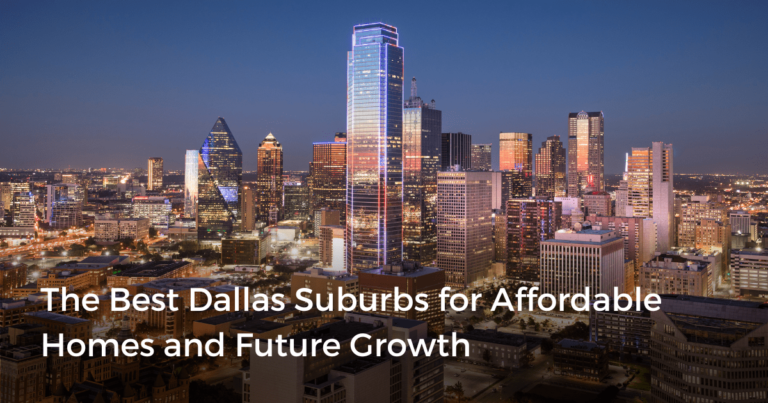The Dallas Business Journal estimates that the Dallas-Fort Worth (DFW) area added close to 500 new residents per day from 2023 to 2024. The metropolitan area is now home to over 8 million residents.
As one of the biggest cities in the country, it can be difficult to determine which is the best Dallas suburb for you to move to. Some suburbs offer great connectivity to downtown, but come at a steep price. Other suburbs are further away from the core, but won’t stretch your budget.
When you’re buying a home, thinking strategically about the potential for future price appreciation is also important. Moving to a rapidly growing suburb can help you build equity. At the same time, you don’t want to pay more than what your income allows.
That’s where Zoocasa comes in. We analyzed 42 Dallas suburbs, ranking them by affordability, price appreciation, population growth, and convenience to help you find the best suburb in the city to buy a home in.
The final score was calculated using five key metrics: average single-family home price, 10-year home price growth, median household income, 1-year population growth, and walk score. Each metric was normalized and weighted according to its importance in evaluating the overall ranking. Home price affordability carried the greatest weight, followed by home price growth, income, population growth and walk score.
The top three best Dallas suburbs to buy a home in are all located in Collin County: Melissa, Celina, and Princeton.
What makes these three suburbs stand out? Residents earn relatively high incomes while home prices remain comparatively affordable. In Melissa, the median household income of $137,875 is more than enough to afford the average home price of $476,813. Home prices are also appreciating fast. From 2015 to 2025, the average home price in Melissa increased by 104.6%, indicating a high probability of homeowners building equity here.
Similarly, Celina has one of the highest median household incomes in the DFW area at $155,875. With that income, a buyer could afford a home priced up to $719,282 (assuming a 30-year fixed mortgage at 6.5% and a 20% down payment). That figure is well above Celina’s average home price of $536,374. The city’s population has also risen by 18.2% since 2023, positioning homes for continued price growth.
Only Princeton has Celina beat with a 1-year population growth of 30.6%. While its 10-year home price growth has been a more modest 88.7%, prices are likely to rise more rapidly going forward. As new residents arrive, additional services and infrastructure will follow to keep up with demand, further boosting Princeton’s desirability. With an average home price of $316,983, the city also offers newcomers an affordable investment opportunity.
Where to Go If You Want the Lowest Home Price
Among the 42 suburbs analyzed, Lancaster has the lowest home price at $264,270. That’s almost a third of the Dallas County average price, which sits above $600,000.
But Lancaster’s community is growing more slowly than others, with its population increasing by just 0.2% from 2023 to 2024. That may not be a drawback if you enjoy a slower pace of life and quieter residential streets. Still, limited growth could also signal weaker future demand, which may keep price gains more moderate.
Meanwhile, Terrell, Mesquite, and Royse City are also very affordable Dallas suburbs. Among these, Royse City has experienced the fastest growth, with the population increasing by 8.8% since 2023. Over the past decade, Royse City’s home values rose a moderate 62.6%, but its rising population could put added pressure on prices moving forward.
Where Home Prices are Appreciating the Fastest
Cedar Hill saw the highest home price growth over the past decade, with the average single-family home price climbing 166.2% since 2015. Even with that sharp increase, prices remain relatively affordable at $441,464, placing Cedar Hill fourth in our ranking of the best Dallas suburbs to buy a home.
DeSoto followed with the second-highest price growth, rising 153.1% over the same period. While it ranks a bit lower on the list at number 11, DeSoto still offers strong investment potential. Its average home price of $423,567 is below the Dallas County average, and its population is growing modestly at 0.6%—a faster pace than nearby areas such as Duncanville and Lancaster.

University Park landed at the bottom of our ranking, but that doesn’t mean it’s a bad place to buy a home. In fact, it is one of the most desirable Dallas suburbs to live in—just not for the median-income family.
The community boasts one of the highest, if not the highest, median household incomes in the area at over $250,000. Even so, that level of income is stretched thin against the average home price of $2.8 million.
On the other end of the spectrum, Mesquite has a very affordable home price of $292,346. However, its median household income is low at $67,333. However, its comparatively low median household income of $67,333 makes homeownership challenging for many local residents, which contributed to its ranking of 10.
That said, Mesquite remains appealing for buyers with above-average incomes. The suburb has seen strong price appreciation over the past decade, making it a promising investment opportunity for those able to enter the market.
Methodology:
Average single-family home prices were sourced from the MetroTex Association of Realtors for July 2025.
Median incomes and population changes were sourced from the U.S. Census Bureau using the latest available figures. Population changes represent the year-over-year change from July 2023 to July 2024.
Walk scores were gathered from Walkscore.com to assess each city’s walkability.
Each metric was normalized and weighted to reflect its importance in determining the overall ranking. The following are each category’s weight: Home prices (45%), home price growth (20%), income (20%), and walk score (5%).
Considering a move to Dallas? Start your search today!
